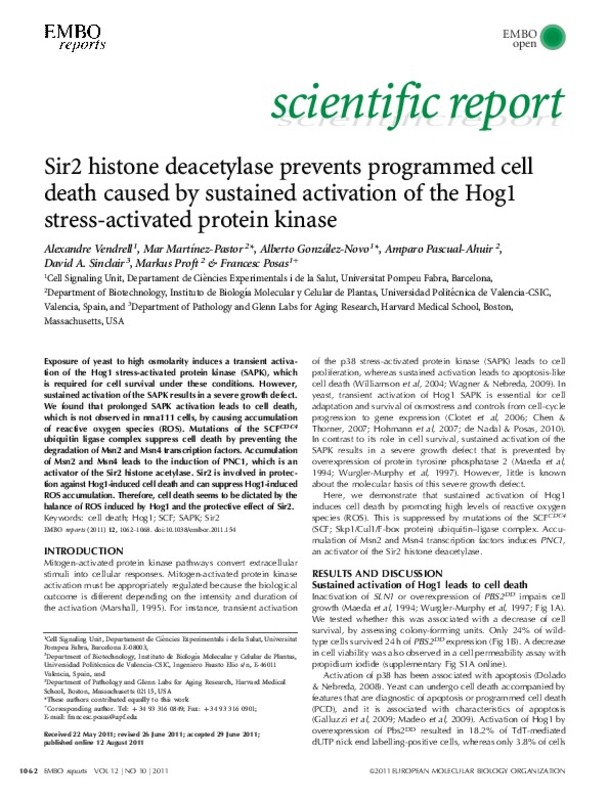JavaScript is disabled for your browser. Some features of this site may not work without it.
Buscar en RiuNet
Listar
Mi cuenta
Estadísticas
Ayuda RiuNet
Admin. UPV
Sir2 histone deacetylase prevents programmed cell death caused by sustained activation of the Hog1 stress-activated protein kinase
Mostrar el registro sencillo del ítem
Ficheros en el ítem
| dc.contributor.author | Vendrell, Alexandre
|
es_ES |
| dc.contributor.author | Martínez Pastor, María Mar
|
es_ES |
| dc.contributor.author | González-Novo, Alberto
|
es_ES |
| dc.contributor.author | Pascual-Ahuir Giner, María Desamparados
|
es_ES |
| dc.contributor.author | Sinclair, David A.
|
es_ES |
| dc.contributor.author | Proft, Markus
|
es_ES |
| dc.contributor.author | Posas, Francesc
|
es_ES |
| dc.date.accessioned | 2015-05-04T11:49:42Z | |
| dc.date.issued | 2011 | |
| dc.identifier.issn | 1469-221X | |
| dc.identifier.uri | http://hdl.handle.net/10251/49610 | |
| dc.description.abstract | [EN] Exposure of yeast to high osmolarity induces a transient activation of the Hog1 stress-activated protein kinase (SAPK), which is required for cell survival under these conditions. However, sustained activation of the SAPK results in a severe growth defect. We found that prolonged SAPK activation leads to cell death, which is not observed in nma111 cells, by causing accumulation of reactive oxygen species (ROS). Mutations of the SCFCDC4 ubiquitin ligase complex suppress cell death by preventing the degradation of Msn2 and Msn4 transcription factors. Accumulation of Msn2 and Msn4 leads to the induction of PNC1, which is an activator of the Sir2 histone acetylase. Sir2 is involved in protection against Hog1-induced cell death and can suppress Hog1-induced ROS accumulation. Therefore, cell death seems to be dictated by the balance of ROS induced by Hog1 and the protective effect of Sir2. | es_ES |
| dc.description.sponsorship | We thank L. Subirana, S. Ovejas and O. Fornas for technical support; G. Ammerer, J. Clotet, X. Escote and G. Mas for their helpful advice and contribution; and E. de Nadal for constant advice and support. This work was supported by grants from the Ministerio de Ciencia y Innovacion (BIO2009-07762) and Consolider Ingenio 2010 programme (grant CSD2007-0015), UNICELLSYS from FP7, as well as supported by Fundacion Marcelino Botin. F.P. is the recipient of the Institucio Catalana de Recerca i Estudis Avancats Academia (Generalitat de Catalunya). D.A.S. is supported by grants from the National Institute on Aging/ | en_EN |
| dc.language | Inglés | es_ES |
| dc.publisher | EMBO Press | es_ES |
| dc.relation.ispartof | EMBO Reports | es_ES |
| dc.rights | Reserva de todos los derechos | es_ES |
| dc.subject | Cell death | es_ES |
| dc.subject | Hog1 | es_ES |
| dc.subject | SCF | es_ES |
| dc.subject | SAPK | es_ES |
| dc.subject | Sir2 | es_ES |
| dc.subject.classification | BIOQUIMICA Y BIOLOGIA MOLECULAR | es_ES |
| dc.title | Sir2 histone deacetylase prevents programmed cell death caused by sustained activation of the Hog1 stress-activated protein kinase | es_ES |
| dc.type | Artículo | es_ES |
| dc.embargo.lift | 10000-01-01 | |
| dc.embargo.terms | forever | es_ES |
| dc.identifier.doi | 10.1038/embor.2011.154 | |
| dc.relation.projectID | info:eu-repo/grantAgreement/MICINN//BIO2009-07762/ES/Control De La Expresion Genica Y Del Ciclo Celular Por Quinasas De Respuesta A Estres/ | es_ES |
| dc.relation.projectID | info:eu-repo/grantAgreement/EC/FP7/201142/EU/Eukaryotic unicellular organism biology – systems biology of the control of cell growth and proliferation/UNICELLSYS/ | |
| dc.relation.projectID | info:eu-repo/grantAgreement/MEC//CSD2007-00015/ES/INESTABILIDAD GENOMICA/ | es_ES |
| dc.rights.accessRights | Abierto | es_ES |
| dc.contributor.affiliation | Universitat Politècnica de València. Departamento de Biotecnología - Departament de Biotecnologia | es_ES |
| dc.description.bibliographicCitation | Vendrell, A.; Martínez Pastor, MM.; González-Novo, A.; Pascual-Ahuir Giner, MD.; Sinclair, DA.; Proft, M.; Posas, F. (2011). Sir2 histone deacetylase prevents programmed cell death caused by sustained activation of the Hog1 stress-activated protein kinase. EMBO Reports. 12(10):1062-1068. https://doi.org/10.1038/embor.2011.154 | es_ES |
| dc.description.accrualMethod | S | es_ES |
| dc.relation.publisherversion | http://dx.doi.org/10.1038/embor.2011.154 | es_ES |
| dc.description.upvformatpinicio | 1062 | es_ES |
| dc.description.upvformatpfin | 1068 | es_ES |
| dc.type.version | info:eu-repo/semantics/publishedVersion | es_ES |
| dc.description.volume | 12 | es_ES |
| dc.description.issue | 10 | es_ES |
| dc.relation.senia | 215039 | |
| dc.identifier.eissn | 1469-3178 | |
| dc.identifier.pmid | 21836634 | en_EN |
| dc.identifier.pmcid | PMC3185340 | en_EN |
| dc.contributor.funder | European Commission | |
| dc.contributor.funder | Ministerio de Ciencia e Innovación | |
| dc.contributor.funder | Ministerio de Educación y Ciencia | es_ES |
| dc.contributor.funder | Institució Catalana de Recerca i Estudis Avançats | es_ES |
| dc.contributor.funder | National Institute on Aging, EEUU | es_ES |








